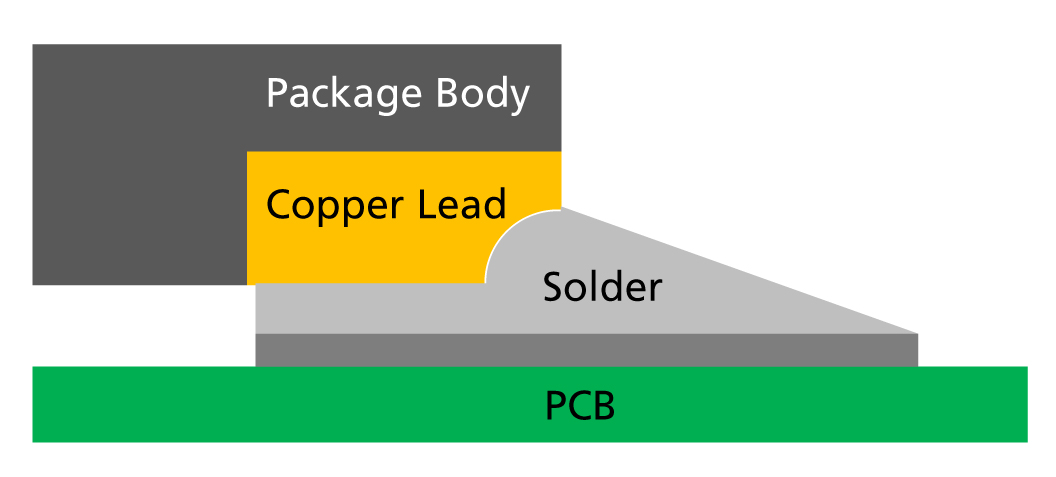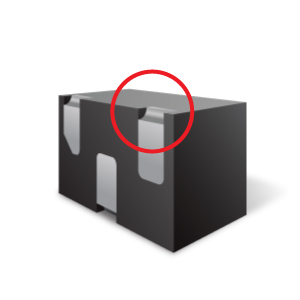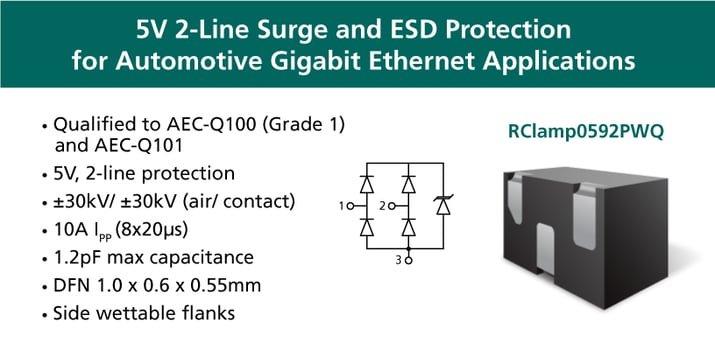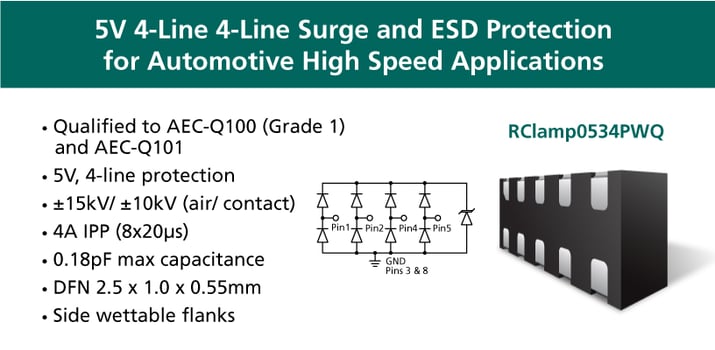Side-Wettable Flanks for Automotive Industry
Since its initiation in the early 20th century, the automotive industry has evolved significantly, adopting many innovations, changes and adaptations. Modern cars feature sophisticated capabilities such as the backup camera, a full-featured infotainment system, smartphone docks, GPS navigation, Bluetooth connectivity, and several other advanced features. Not only that, some of the recent car models are capable of autonomous driving, forward and rear collision detection, and autonomous parking. It is easily imaginable that the numbers of electronic components used in a vehicle are proliferating. At the same time, the requirement for miniaturization of the electronic components is becoming critical to make space for new components.
The semiconductor industry is producing leadless packages of integrated circuits (ICs) to make room for the enormous number of electronic components and meet modern-day vehicles' safety and reliability requirements. A big challenge is the lack of visibility of the solder joints on the printed circuit boards (PCBs) during the post package assembly process. The connections are beneath the package and are not visible from the top and the side. So you cannot say for sure if the IC is adequately bonded to the PCB or not. Original equipment manufacturers (OEMs) have been using X-ray machines to detect unreliable solder joints. It is expensive and time-consuming to do so.
Moreover, this has not proven effective with multilayer boards or boards with complex layouts and routing procedures. Each vehicle PCB has to go through a strict automatic visual inspection (AVI) post assembly to comply with safety and reliability standards. The goal is to ensure that every electrical joint is adequately soldered and connections are reliable.
Introducing Side-Wettable Flanks
To make the assembly process more manufacturable and economical, packages with side-wettable flanks were developed. Side-wettable flank is a technology that allows a portion of the lead to be visible on the edge of a package. This, in turn, allows for visual examination of the formed solder fillets, which are “bumps” formed between the vertical side of the lead and the solder pad on the PCB. The solder fillets in such side-flank leadless packages allow inspection and testing of the solder joints even when most of the IC is not visible when soldered. The copper leads are tin plated to allow the solder joints to spread from the bottom and flow up the side wall of the IC. So after the soldering is complete, it becomes easy to examine if the IC is actually bonded to the PCB. With the side-wettable flanks as shown in Figure 1, AVI can easily detect if there are any improper solder joints.
 Figure 1. Depiction of side-wettable flank
Figure 1. Depiction of side-wettable flank
Side-wettable flanks have several other advantages as well. It increases reliability, and that improves yield. At the same time, it saves manufacturing cost and time. With this package technology, ICs can be designed with flexible form factor and size. Since tin plating is used to cover the copper terminals, it acts as a protection layer and helps protect the copper from oxidation over time.
Semtech offers numerous automotive graded transient voltage suppressor (TVS) diodes in DFN packages with side-wettable flank options across its entire portfolio of automotive circuit protection products. The saw step cut side-wettable flank technology, as shown in Figure 2, is used for the automotive circuit protection products at Semtech. This not only saves board space but also offers superb visibility of solder joints for AVI. That is how this technology allows the achievement of safety and reliability standards in the automotive industry.
 Figure 2. Side-wettable flanks in automotive TVS diodes
Figure 2. Side-wettable flanks in automotive TVS diodes
Solutions from Semtech for Automotive TVS
Now let us look into Semtech's portfolio of electrostatic discharge (ESD) protection TVS diodes with side-wettable flanks for various automotive applications. The first product we discuss is a TVS diode for the ESD protection of the controller area network or CAN Bus. There are several bus interfaces used in automotive applications. The CAN Bus allows microcontrollers and other control units to communicate with each other.
 Semtech offers µClamp®2424PWQ, a 24V TVS diode in DFN (2.5x1.0x0.55mm) package with state-of-the-art side-wettable flank technology to protect CAN Bus during ESD and electrical overstress (EOS) events. µClamp2424PWQ provides 4 lines of transient protection to ESD events at ±30kV (air) and ±30kV (contact) as per the IEC 61000-4-2 standard. It has an extremely low capacitance of 18pF (max), and each line is rated for a maximum EOS current of 5A (tp = 8/20μs).
Semtech offers µClamp®2424PWQ, a 24V TVS diode in DFN (2.5x1.0x0.55mm) package with state-of-the-art side-wettable flank technology to protect CAN Bus during ESD and electrical overstress (EOS) events. µClamp2424PWQ provides 4 lines of transient protection to ESD events at ±30kV (air) and ±30kV (contact) as per the IEC 61000-4-2 standard. It has an extremely low capacitance of 18pF (max), and each line is rated for a maximum EOS current of 5A (tp = 8/20μs).
The second product is a TVS diode that protects automotive gigabit Ethernet. An ever-growing number of features and in-car applications continues to drive the need for higher bandwidth in automobiles, which is being satisfied by employing Ethernet technology. When designing a system to that deploys a high-speed interface like Ethernet in a harsh automotive environment, it is imperative to ensure sufficient ESD protection is provided to achieve reliable operation during undesirable transient events.
 Semtech's RClamp®0592PWQ, which also has a wettable side flank, is specifically designed to provide surge and ESD protection on automotive gigabit Ethernet ports. It protects two high-speed data lines with a typical junction capacitance of 1.2pF. It has an operating voltage of 5.0V and has a meager dynamic resistance of 0.07Ω (typical). RClamp0592PWQ is available in a 3 pin DFN package (1.0 x 0.6 x 0.55 mm ).
Semtech's RClamp®0592PWQ, which also has a wettable side flank, is specifically designed to provide surge and ESD protection on automotive gigabit Ethernet ports. It protects two high-speed data lines with a typical junction capacitance of 1.2pF. It has an operating voltage of 5.0V and has a meager dynamic resistance of 0.07Ω (typical). RClamp0592PWQ is available in a 3 pin DFN package (1.0 x 0.6 x 0.55 mm ).
The other interfaces that need to be protected from ESD and EOS events in an automotive environment are high-speed data transmission interfaces like HDMI and display port. Semtech's RClamp0534PWQ is precisely suited to protect four high-speed data lines. It has a maximum junction capacitance of 0.18pF between I/O pins and GND. With an operating voltage of 5V and a minimum breakdown voltage of 5.5V, RClamp0534PWQ is available in a 10 pin DFN package (2.5 x 1.0 x 0.55 mm) with side-wettable flanks.
 Semtech is a leading manufacturer of TVS diodes that protects many of the world's most popular automotive model's electronic gadgets. In the harsh automotive environment, careful design and proper selection of TVS diodes is essential for safeguarding the communication buses and interfaces. Conformance to level 4 IEC61000-4-2 standard along with AEC-Q qualification is mandatory for automotive system design. Packages designed with side-wettable flanks are becoming essential in most automotive applications. Semtech's highly efficient and trusted portfolio of TVS products with side-wettable flanks protect high-speed data buses and other communication buses present in an automobile.
Semtech is a leading manufacturer of TVS diodes that protects many of the world's most popular automotive model's electronic gadgets. In the harsh automotive environment, careful design and proper selection of TVS diodes is essential for safeguarding the communication buses and interfaces. Conformance to level 4 IEC61000-4-2 standard along with AEC-Q qualification is mandatory for automotive system design. Packages designed with side-wettable flanks are becoming essential in most automotive applications. Semtech's highly efficient and trusted portfolio of TVS products with side-wettable flanks protect high-speed data buses and other communication buses present in an automobile.
To learn more about Semtech's product offerings for the automotive industry, visit Semtech's Automotive Circuit Protection product site.
Semtech®, the Semtech logo, RClamp®, and µClamp® are registered trademarks or service marks of Semtech Corporation or its affiliates. Other product or service names mentioned herein may be the trademarks of their respective owners.
